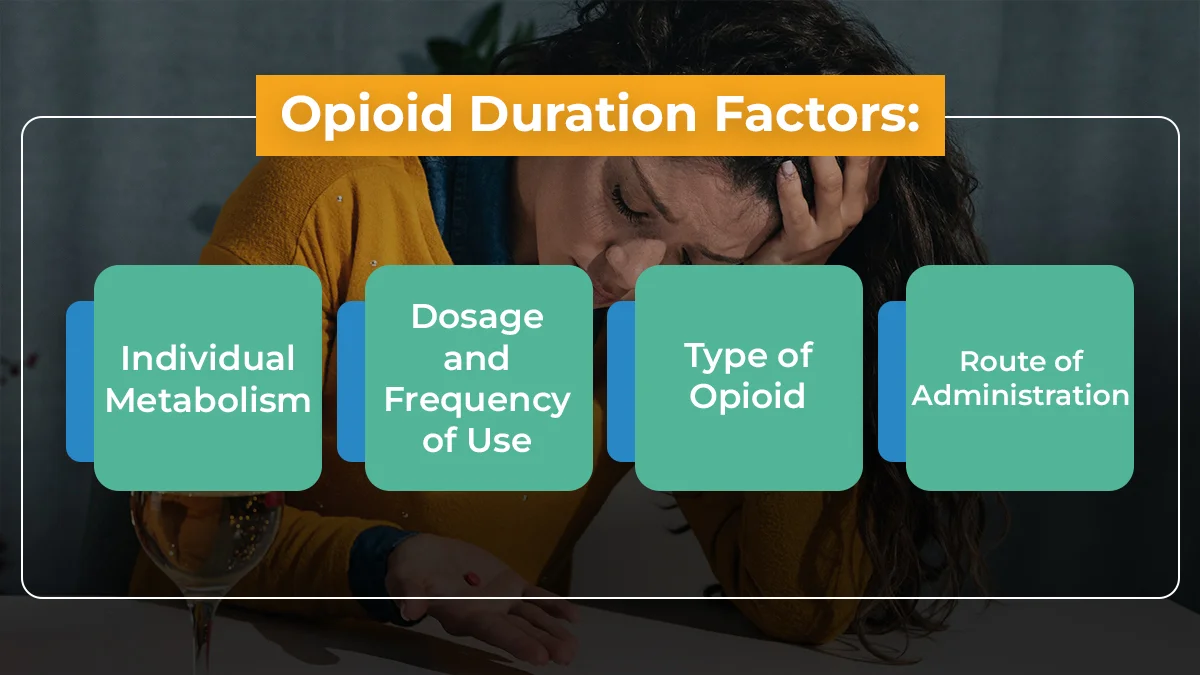Inside Your System: Navigating the Opioid Stay
Opioids are a class of drugs that include both prescription pain relievers like hydrocodone, oxycodone, and morphine, as well as illegal substances like heroin. They work by attaching to opioid receptors in the brain, reducing the perception of pain and creating feelings of euphoria.
When talking about how long opioids stay in your system, it is essential to note that duration can vary depending on various factors. This article will delve into these durations and influencing factors, offering insights to those undergoing medical treatment or drug screenings.
Key Takeaways
Opioids are potent pain-relieving medications with varying detection periods in the body. Here is what this article touches upon:
- Opioid metabolism involves the liver breaking down these medications, influencing their duration and effects.
- Different drug tests can be used to detect opioids, with detection windows varying based on the test type.
- Various factors influence how long opioids remain detectable in the system, including metabolism and dosage.
Reach out to The Recovery Team today at (800) 817-1247 to start reclaiming your life from substance use disorder (SUD) through evidence-based treatment.
What are Opioids
Opioids are a group of potent drugs primarily used for chronic pain management. These drugs work by attaching to specific receptors in the brain, reducing pain signals and altering how the body senses discomfort.
Doctors often prescribe opioids to manage severe pain from injuries, surgeries, or chronic conditions like cancer. However, these medications carry risks of addiction and misuse due to their strong impact on the body and mind.
Here are some common types of opioids:
Natural Opioids: These opioids are derived directly from the opium poppy plant. Common examples include morphine and codeine.
Semi-synthetic Opioids: These are chemically modified forms of natural opioids. Examples include oxycodone, hydrocodone, and heroin (which is derived from morphine).
Fully Synthetic Opioids: These are manufactured in the lab and not derived from natural sources. Fentanyl and methadone are examples of fully synthetic opioids.
Each type differs in potency and duration of action. Some opioids are short-acting, providing quick relief but staying in the body for a shorter time. In contrast, others are long-acting opioids, offering prolonged pain relief but remaining detectable for longer periods in the system.
Opioid Metabolism: How Body Process Pain Medications
Opioid metabolism refers to how the body breaks down and handles opioids. When someone takes an opioid medication, like morphine or oxycodone, the body starts to process it. The liver is a key player in this process. It’s like a filter that takes the opioid and changes it into different substances.
Enzymes in the liver get to work on the opioid, breaking it down into smaller parts. These parts are called metabolites. As the opioid breaks down, it becomes less active in the body. Eventually, these metabolites are transformed into waste products that the body can easily eliminate through urine or stool.
The process of opioid metabolism can vary from person to person. Some people break down opioids faster or slower than others due to differences in their body’s enzymes. This can influence how effective the pain relief is and how likely someone is to have side effects.
How Long Opioids Stay in the Body
When it comes to detecting opioids in the body, various drug tests can provide insights into their presence and duration. Each type of test has its window of detection, offering distinct timelines for how long opioids linger in the system after their use.
Urine Test
Urine testing is commonly used to detect opioids and typically has a detection window of 2 to 4 days after the last use. However, certain opioids may remain detectable for a more extended period, up to a week.
Blood Test
In blood tests, opioids are usually detectable for a shorter time frame compared to urine drug tests. They can be identified within hours of intake and generally remain detectable for about 12-24 hours.
Saliva Test
Saliva tests can detect opioids for a shorter window compared to urine and blood tests. Opioids are usually detectable in saliva within minutes of consumption and can be identified for up to 1-4 days.
Hair Follicle Test
Hair follicle tests come with a longer detection window. Opioids can be detected in hair for up to 90 days after use, providing a broader timeline for identifying past opioid consumption.
Remember, these are general estimates, and individual variations can occur. Additionally, advancements in drug testing technologies may influence detection times.
Varied Opioid Durations: Understanding the Factors
Several factors influence how long opioids stay in the body and can affect the duration they remain detectable in drug tests. Here is the breakdown of these factors:
Individual Metabolism
Individual metabolism plays a significant role in how quickly the body processes opioids. Some people metabolize these drugs faster, leading to a shorter duration of action, while others might have a slower metabolism, prolonging the drug’s effects and detection period.
Dosage and Frequency of Use
The amount and frequency of opioid intake directly impact how long they stay in the system. Higher doses or frequent use can extend the duration of detection in drug tests, as the body takes longer to eliminate larger amounts of the drug.
Type of Opioid
Different opioids have varying half-lives, affecting how long they remain in the body. Short-acting opioids like heroin might clear out faster compared to longer-acting ones such as methadone, which can linger for an extended period.
Individual Differences
Individual differences, including age, weight, overall health, and genetics, influence opioid metabolism. Factors like liver or kidney function can affect how efficiently the body breaks down and eliminates opioids.
Route of Administration
The way opioids are taken also affects their duration in the body. Oral ingestion typically leads to a longer presence compared to smoking or injection, which can result in a quicker elimination from the system.
Drug Interactions
Interactions with other medications or substances can alter how long opioids stay in the body. Some drugs can slow down or speed up the metabolism of opioids, impacting their duration and effectiveness.
Testing Sensitivity
The sensitivity of drug tests varies, influencing their ability to detect opioids. More sensitive tests can detect smaller amounts of opioids and for a longer duration compared to less sensitive ones.
Understanding these diverse factors is critical in interpreting drug test results accurately, tailoring treatment plans, and implementing effective strategies for pain management and addiction treatment.
When to Seek Help: Signs of Opioid Addiction
Recognizing the right time to seek help for opioid addiction is crucial for individuals struggling with substance abuse. Knowing the signs and understanding when to reach out for support can be a pivotal step towards recovery and a healthier life.
Signs and Symptoms
Being aware of the signs and symptoms of opioid addiction is the first step. These may include increased tolerance, needing high doses for the same effect, withdrawal symptoms when not using, neglecting responsibilities, changes in behavior or mood, and continued use despite negative consequences. If these signs become noticeable and begin affecting daily life, it’s advisable to consider seeking help.
Impact on Daily Life
When opioid use starts interfering with daily activities such as work, school, relationships, or personal health, it’s a clear indication that professional assistance may be necessary. If someone finds it challenging to function normally without opioids or if their usage is causing harm to themselves or others, seeking help becomes crucial.
Failed Attempts to Quit
Continued attempts to quit or cut back on opioid use without success might indicate a need for specialized assistance. Opioid addiction can be challenging to overcome alone due to withdrawal symptoms and the strong pull of addiction. Seeking professional help can significantly improve the chances of successful recovery.
Concern from Loved Ones
Often, friends and family members may notice concerning behaviors or changes in a person struggling with opioid addiction. If loved ones express worry or recommend seeking help, it’s essential to consider their perspective and seek professional medical advice. Their observations might provide valuable insight into the severity of the situation.
The sooner one seeks help for opioid addiction, the better the chances of successful recovery. Treatment options are available, including medical detox programs, therapy, medication-assisted treatment (MAT), support groups, and rehabilitation programs tailored to individual needs.
The Recovery Team and You: A Winning Combination
Are you struggling with opioid use disorder (OUD)? The Recovery Team is here, rooting for your strength to conquer this menace.
Reclaim your life with our tailored programs, offering a range of care options. Whether you need inpatient care in a residential program or a more flexible approach through outpatient treatment, we’re right by your side.
Our therapy programs, including cognitive behavioral therapy (CBT) and relapse prevention therapy, address emotional and behavioral concerns through both individual and group sessions, ensuring safe and effective addiction treatment and significantly minimizing the risk of relapse.
Now is the time to take action and reclaim your life. Contact us today at (800) 817-1247. The path to recovery starts with this first step, and we are here to guide you.






